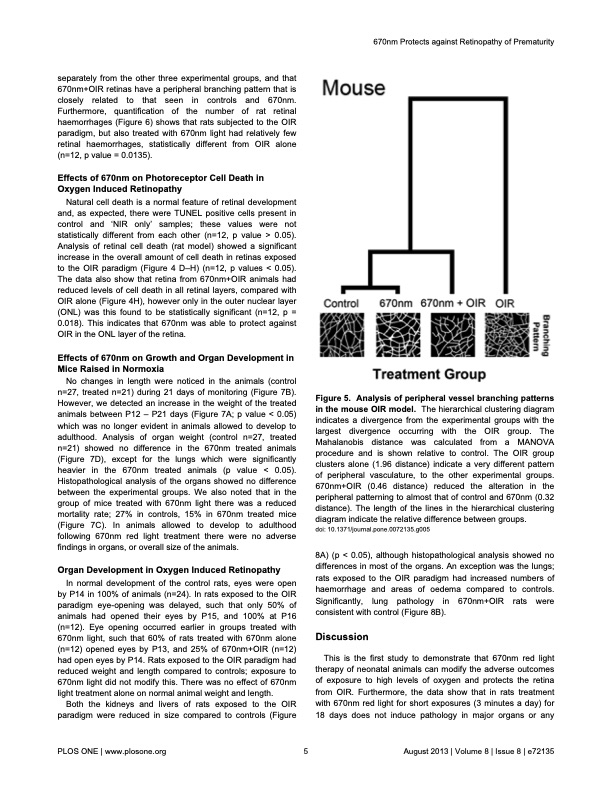
PDF Publication Title:
Text from PDF Page: 005
separately from the other three experimental groups, and that 670nm+OIR retinas have a peripheral branching pattern that is closely related to that seen in controls and 670nm. Furthermore, quantification of the number of rat retinal haemorrhages (Figure 6) shows that rats subjected to the OIR paradigm, but also treated with 670nm light had relatively few retinal haemorrhages, statistically different from OIR alone (n=12, p value = 0.0135). Effects of 670nm on Photoreceptor Cell Death in Oxygen Induced Retinopathy Natural cell death is a normal feature of retinal development and, as expected, there were TUNEL positive cells present in control and ‘NIR only’ samples; these values were not statistically different from each other (n=12, p value > 0.05). Analysis of retinal cell death (rat model) showed a significant increase in the overall amount of cell death in retinas exposed to the OIR paradigm (Figure 4 D–H) (n=12, p values < 0.05). The data also show that retina from 670nm+OIR animals had reduced levels of cell death in all retinal layers, compared with OIR alone (Figure 4H), however only in the outer nuclear layer (ONL) was this found to be statistically significant (n=12, p = 0.018). This indicates that 670nm was able to protect against OIR in the ONL layer of the retina. Effects of 670nm on Growth and Organ Development in Mice Raised in Normoxia No changes in length were noticed in the animals (control n=27, treated n=21) during 21 days of monitoring (Figure 7B). However, we detected an increase in the weight of the treated animals between P12 – P21 days (Figure 7A; p value < 0.05) which was no longer evident in animals allowed to develop to adulthood. Analysis of organ weight (control n=27, treated n=21) showed no difference in the 670nm treated animals (Figure 7D), except for the lungs which were significantly heavier in the 670nm treated animals (p value < 0.05). Histopathological analysis of the organs showed no difference between the experimental groups. We also noted that in the group of mice treated with 670nm light there was a reduced mortality rate; 27% in controls, 15% in 670nm treated mice (Figure 7C). In animals allowed to develop to adulthood following 670nm red light treatment there were no adverse findings in organs, or overall size of the animals. Organ Development in Oxygen Induced Retinopathy In normal development of the control rats, eyes were open by P14 in 100% of animals (n=24). In rats exposed to the OIR paradigm eye-opening was delayed, such that only 50% of animals had opened their eyes by P15, and 100% at P16 (n=12). Eye opening occurred earlier in groups treated with 670nm light, such that 60% of rats treated with 670nm alone (n=12) opened eyes by P13, and 25% of 670nm+OIR (n=12) had open eyes by P14. Rats exposed to the OIR paradigm had reduced weight and length compared to controls; exposure to 670nm light did not modify this. There was no effect of 670nm light treatment alone on normal animal weight and length. Both the kidneys and livers of rats exposed to the OIR paradigm were reduced in size compared to controls (Figure Figure 5. Analysis of peripheral vessel branching patterns in the mouse OIR model. The hierarchical clustering diagram indicates a divergence from the experimental groups with the largest divergence occurring with the OIR group. The Mahalanobis distance was calculated from a MANOVA procedure and is shown relative to control. The OIR group clusters alone (1.96 distance) indicate a very different pattern of peripheral vasculature, to the other experimental groups. 670nm+OIR (0.46 distance) reduced the alteration in the peripheral patterning to almost that of control and 670nm (0.32 distance). The length of the lines in the hierarchical clustering diagram indicate the relative difference between groups. doi: 10.1371/journal.pone.0072135.g005 8A) (p < 0.05), although histopathological analysis showed no differences in most of the organs. An exception was the lungs; rats exposed to the OIR paradigm had increased numbers of haemorrhage and areas of oedema compared to controls. Significantly, lung pathology in 670nm+OIR rats were consistent with control (Figure 8B). Discussion This is the first study to demonstrate that 670nm red light therapy of neonatal animals can modify the adverse outcomes of exposure to high levels of oxygen and protects the retina from OIR. Furthermore, the data show that in rats treatment with 670nm red light for short exposures (3 minutes a day) for 18 days does not induce pathology in major organs or any 670nm Protects against Retinopathy of Prematurity PLOS ONE | www.plosone.org 5 August 2013 | Volume 8 | Issue 8 | e72135PDF Image | 670nm Photobiomodulation as a Novel Protection to Retinopathy

PDF Search Title:
670nm Photobiomodulation as a Novel Protection to RetinopathyOriginal File Name Searched:
05f0c1a1f2e8aec2744443e83bbeec817202.pdfDIY PDF Search: Google It | Yahoo | Bing
Cruise Ship Reviews | Luxury Resort | Jet | Yacht | and Travel Tech More Info
Cruising Review Topics and Articles More Info
Software based on Filemaker for the travel industry More Info
The Burgenstock Resort: Reviews on CruisingReview website... More Info
Resort Reviews: World Class resorts... More Info
The Riffelalp Resort: Reviews on CruisingReview website... More Info
| CONTACT TEL: 608-238-6001 Email: greg@cruisingreview.com | RSS | AMP |